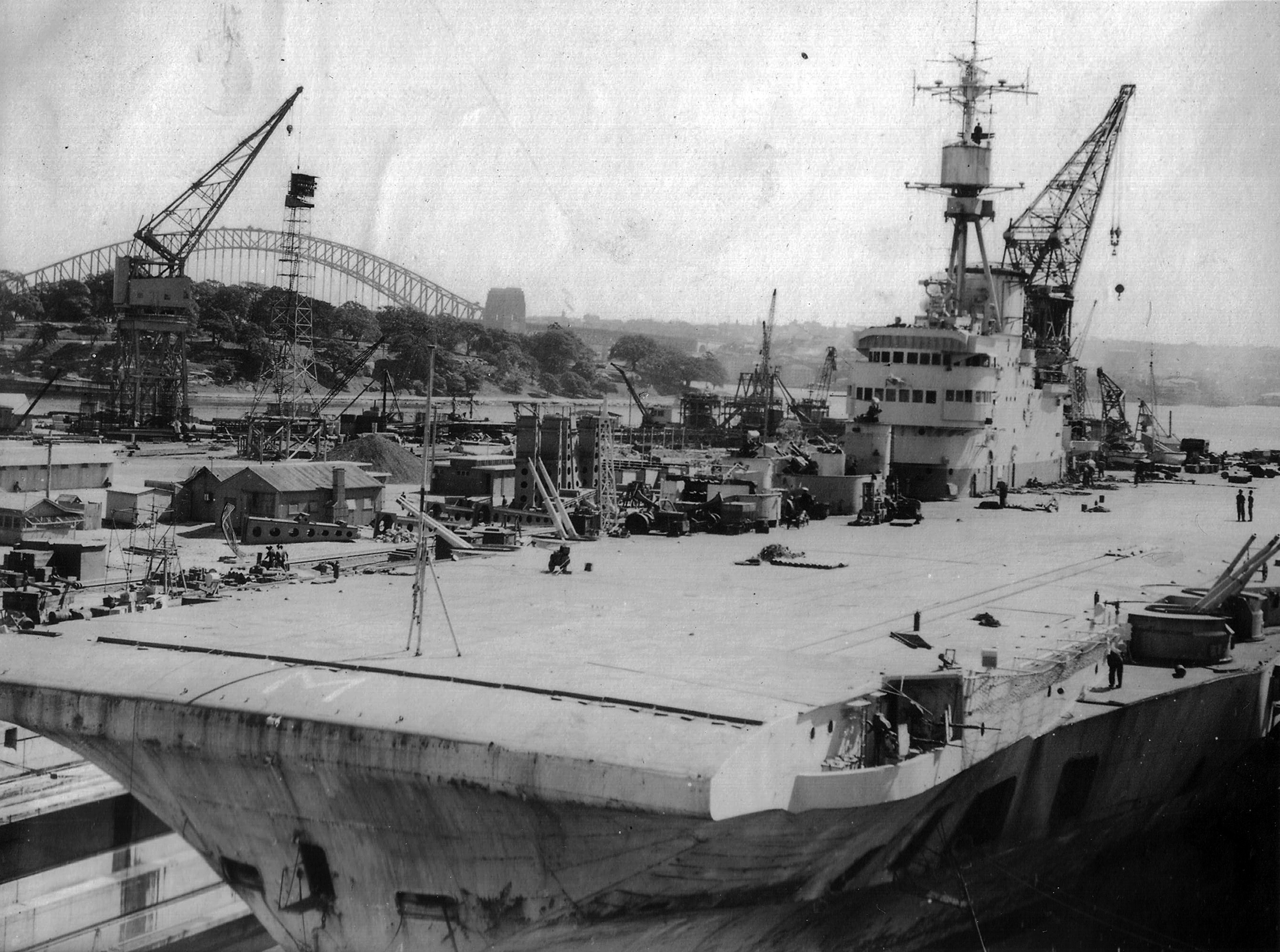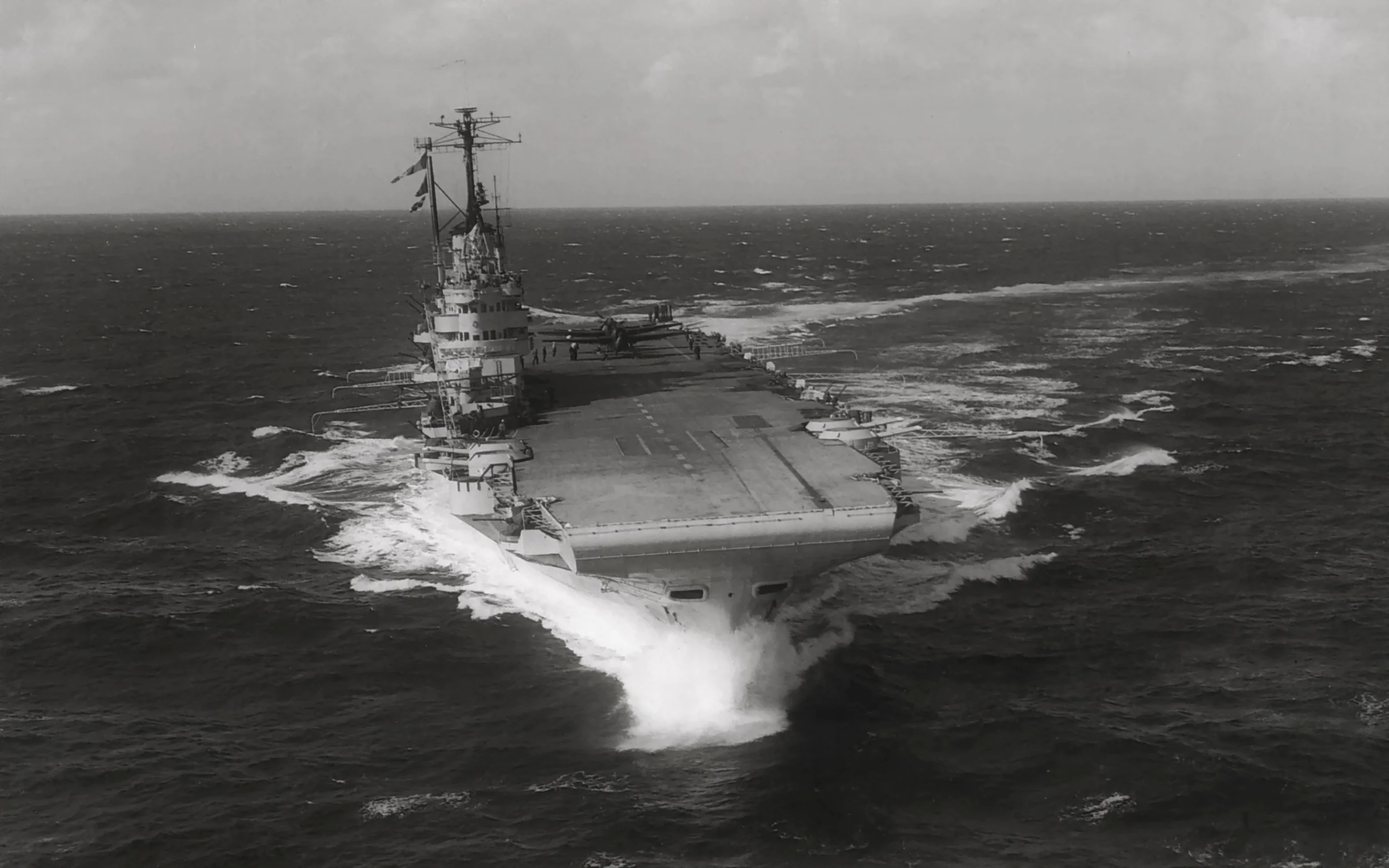As aircraft and radar rapidly evolved, so too did the need for larger carrier air groups. War shortages of armour gave Britain a chance to modify the final Illustrious-class carriers while still on the blocks.
“In 1937, during the rearmament period, it was decided to build two more aircraft carriers on the lines of Illustrious and class, but with improved speed ...
Other requirements for the design were
(i) increase in the number of aircraft carried to improve the attacking power and
(ii) increase in anti-aircraft fire for defensive purposes.”
HMS Implacable bow-on.
Size matters
Even before the war, nervousness among the Royal Navy about the size of the class' air group resulted in the fourth ship – HMS Indomitable – being modified to improve her stowed aircraft capacity to 45. She was given an extra hangar deck, with half the original hangar redesigned to provide extra necessary accommodation space.
The final two ships of the class, HMS Implacable and Indefatigable, were initially to be repeats of Indomitable. Ordered in 1938, variations on requirements were drawn up for a carrier capable of 32 knots and a standard complement of 54 aircraft. Their weight was to remain 23,000 tons.
Work began on HMS Implacable in February 1939, and on Indefatigable in November of the same year.,
Vital war lessons were yet to be learned. But the war – and Prime Minister Winston Churchill – were to intervene.
Construction work was slowed and then suspended after the outbreak of hostilities. The partially constructed hulls sat idle from mid 1940 through much of 1941. This freed up Britain’s manufacturing capacity, supply of armour plate and manpower for more urgent work, such as escort destroyers and trade protection cruisers.
It also provided a limited opportunity to upgrade the Indomitable class' otherwise treaty-era design, though as the hull was already well advanced these could only ever really be regarded as 'tweaks'.
Admiral Henderson’s vision was partly vindicated by HMS Illustrious in January 1941, Formidable in May 1941, and Indomitable in August 1942.
While only Formidable had remained capable of launching and recovering her aircraft during and after the action, all three ships had survived damage that would have sunk others.
But, especially after Pearl Harbor and the carrier-v-carrier clashes of 1942, the value of large air groups as adopted by America and Japan could not be ignored. Especially now that radar made interceptions a viable proposition.
The delay of work on the final two armoured carriers therefore presented an opportunity. A further reworking of their Illustrious-based design could be initiated.
But there was an underlying limit. While the various naval treaties had by now long been torn up, the Implacable class had been designed - and laid down - before the war in Europe and under the old 23,000ton limit.
This would only allow a degree of expansion before the naval laws of scale would necessitate a complete redesign. More aircraft needed more space, but also more aviation fuel and stores. More fuel and stores needed more space, but also more protection. More space and weight needed more propulsion just to maintain the same speed, and extra bunker fuel to go the same distance. But these ships were supposed to go faster …
And this juggling act is where things started to go wrong.
“During the war the concept of a permanent deck park of 20-25 aircraft was accepted. However, aircraft fuel stowage was already limited compared with the provision in USN carriers, partly because of a different concept of operations but also because of the elaborate fire protection given to petrol in British ships. Though this policy, together with the closed hangar, helped the RN to avoid devastating fires, it meant that replenishment was needed frequently.”
Flight Deck
Implacable and Indefatigable would have an effective flight deck length of 760ft and the variable width rated as 90ft. This was a improvement over the earlier Illustrious, even after she had had her round-downs reduced to increase the length to 748ft in 1944.
Implacable and Indefatigable also had a considerably reworked flight deck arrangement.
It was wider over more of its lengh, made possible in part through the redesign of the 4.5in turrets and sponsons. These were now conformal with the flight deck, eliminating the protrusions of the earlier ships.
Deck park facilities such as outriggers were also to be incorporated from the outset.
Freeboard at the flight deck was 50ft, 12ft more than Illustrious and 2ft less than Indomitable.
Lifts
The Implacable class was expected to operate aircraft of up to 20,000lbs, despite the low clearance of their hangars.
As such, both lifts were modified slightly over the earlier design to accommodate these weights at similar speeds.
The forward lift was the largest. Its 45 x 33ft platform served only the main upper hangar.
The rear lift, at the same small 45ft x 22ft dimensions of their older sisters, serviced both levels.
Accelerator
The H-III model accelerator fitted to the port forward side was essentially the same as that installed in the earlier four carriers other than it followed twin guide rails. But it had evolved enough to launch 20,000lb loads at 56 knots. 16,000lb could be catapulted at up to 66knots.
It was also capable of launching American-built aircraft without the one-ton trolley (which ran on twin tracks instead of the earlier model’s one). This weight saving, combined with the tail-down method, boosted launch speeds by up to 4knots up to the maximum 66knots.
Arrester Gear
Aircraft capture equipment was similar to that of the earlier designs, though capable of restraining heavier loads. There were nine arrester wires aft and three forward.
By the later war years the arrester gear was able to snare an aircraft at a maximum landing speed of 75 knots on two-thirds throttle.
In 1945 HMS Implacable recorded an average landing interval for its Seafire IIIs of 43 seconds. One recovery of 18 machines recorded a mere 32 second average cycle time.
“The open hangar extended to the side of the ship and hence provided greater deck area whilst the greater width made it easier to fit in aircraft of different sizes and shapes. The British response to this problem was the double hangar which provided the deck area but was still narrow and introduced problems in getting planes to the deck from the lower hangar.”
Hangars
Both carriers were originally to have a 16ft high lower hangar and a 14ft high upper hangar, as with HMS Indomitable.
The ships were longer than Indomitable, but the main hanger dimensions remained at 458ft by 62ft.
As with Indomitable, not all the lower hangar deck could be retained. Accommodation space was at a premium, so the forward half of the lower space was redesigned from the outset as mess decks, offices and store rooms.
The lower hangar area was 208ft by 62ft.
The total basic design aircraft complement was 48 - though it was already anticipated the ships would operate deck parks as outrigger pylons and other deck-based facilities were fitted before completion.
This explosion in top weight – both from the heavier aircraft expected to be carried and all the additional equipment – threatened the ships’ stability.
Stability was of particular importance for the North Sea environment the carriers were expected to operate in. The cost: Cut the lower hangar down to 14ft.
How this decision was made given the ballooning size and weight of aircraft is incomprehensible.
The opposite should have been the case – discover weight savings elsewhere to make both hangars 16ft high.
But the argument that all future British designs incorporated the lower rearward folding wing system somehow won ascendancy – even though it wasn’t correct.
This decision was to have a severe impact on the usefulness, and therefore lifespan, of these final two armoured carriers. They were not capable of accommodating the F4U Corsair, for example.
On active deployment, the lower half-hangar would often be totally given over to the Air Engineering Department as workshop space. The only aircraft accommodated there would be undergoing servicing or repairs.
After the war plans were drawn up to rebuild the hangar spaces into one large new deck. But there simply was not enough cash available in recession-torn Britain to carry out the work.
R. F. Stevens quoted in Malcolm Smith's. Voices in Flight: The Fleet Air Arm: Recollections from Formation to Cold War
Indefatigable’s job was to fly combat air patrol (CAP) over the Fleet, so we had to have aircraft in the air from dawn to dusk. We would, therefore, range the first eight aircraft from the two middle rows and as soon as they were airborne would range another eight for the second patrol, again from the middle rows. Then we moved all the aircraft round in two big circles by moving the middle rows forward and the outer rows back, across and forward into the middle rows. The first patrol would then be ready to land on, so the second patrol would be flown off and when the first patrol landed on it would be struck down into the outer rows for refuelling, re-arming and clearing any snags. Whilst this was going on the next eight would be ranged for the next patrol and then the whole lot moved round again. Any aircraft seriously unserviceable was left at the back as they circulated. This went on all day and every day that we were striking. Then when we were out oiling we would then have to range a lot of aircraft to get repaired ones out for engine runs etc.
We would be striking for two or three days then pull out about a hundred miles for re-oiling from the Fleet train for two days, then back in striking. When we were striking we were going to action stations about 4am and never leaving the hangar much before midnight. We even ate our food (corned beef sandwiches) while pushing aircraft and our main meal of the day was taken, whenever possible during the evenings when work on the aircraft permitted. That, at least, was in the Mess.
There were a few other minor worries such as Kamikazes but with our armoured flight decks none of the British carriers came to any great harm. This then was the routine worked for close on three months nonstop and then, after a short break in Sydney, for a further six or seven weeks. Couple this with the fact that hangar temperatures were always at least in the nineties and it is no wonder I lost about two stone whilst out there.



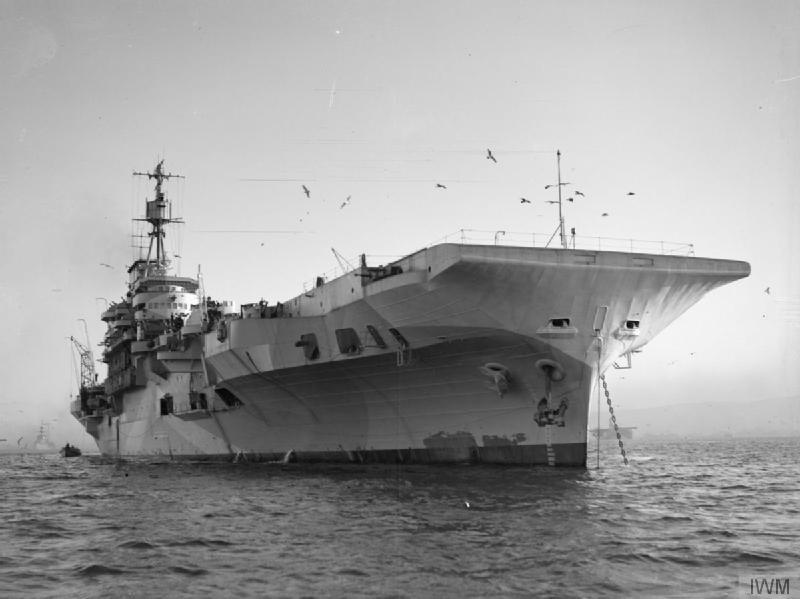
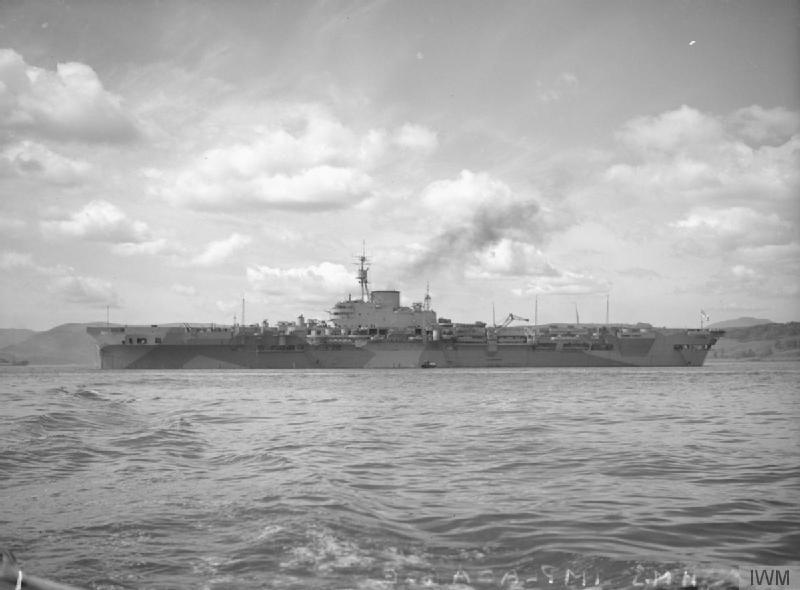


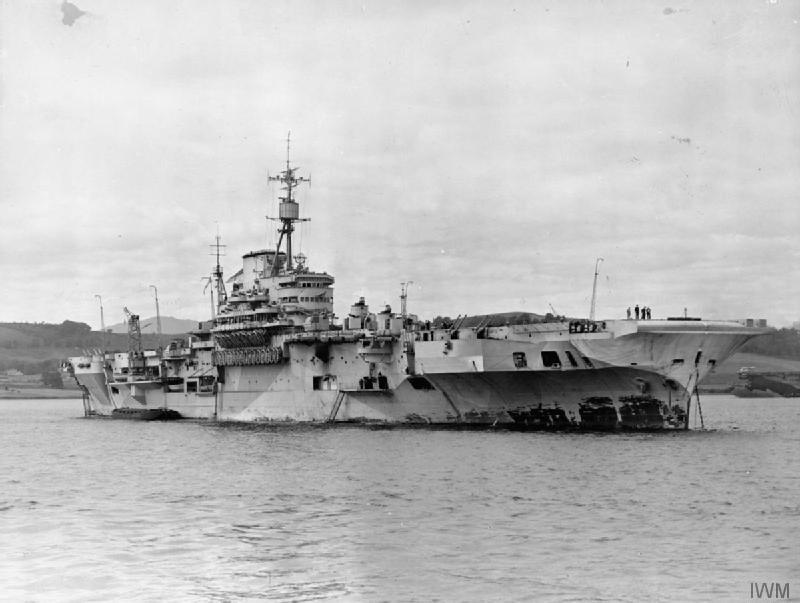
Fire Suppression
Some historians argue that it was not the armoured flight deck that saved the six ships of the class from loss during World War II. Instead, it was their fire protection systems.
Implacable and Indefatigable inherited this emphasis from their sisters.
Ventilation systems prevented their closed hangars from building up avgas fumes and drains carried excess water from the sprinklers and fire hoses over the side to avoid capsize.
Both ships were completed with asbestos fire curtains which divided the upper hangar in three. The salt-water hangar spray system which was a feature of British carrier design was repeated.
Hull
The two new ships were to have the same beam as their older sisters as they faced the same docking limitations. But they were to be 26ft longer to allow greater space for the multitude of modifications being demanded.
The flight deck was 50ft above the waterline, 12ft more than HMS Illustrious and 2ft less than Indomitable.
Machinery
The Royal Navy also sought to squeeze in four propulsion shafts, instead of the previous three, in order to boost power output by up to a third.
Somehow the designers managed to fit these in the same space occupied by three sets of machinery in Illustrious: The only obvious external difference being a somewhat larger funnel.
One major improvement was less obvious. The weakness of low smoke ducts from the boiler spaces which had seen HMS Ark Royal capsize after seemingly only moderate torpedo damage would not be repeated.
Shortening the lower hangar space allowed the trunking to be carried higher, lifting them above the threat of in-rushing water from moderate lists.
Total power output was 152,000hp, propelling the carriers on trials at up to 32.3 knots. It was found that under operational conditions, Implacable and Indefatigable could maintain 31 knots with ease.
Ironically, it was the technical success of squeezing in the fourth shaft that caused serious practical problems for Indefatigable and Implacable. It represented a whole new set of stokers and engineers that had to be accommodated in ships little bigger than their predecessor, Indomitable.
As a result, crowding was severe and more space had to be set aside forward of the lower hangar for messes and crew facilities.
“It is worth noting that the protection on the side of the hangar was gradually reduced in thickness in later classes eventually becoming little more than splinter protection.”
Protection
The flight deck above the upper hangar space would be covered by 3in armour plate, and the spaces around the lifts would necessarily remain strengthened steel.
But concerns about the effectiveness of Indomitable’s greatly reduced hangar side armour emerged shortly after the final two carriers were ordered. Bombs were now being delivered at greater speeds at lower altitudes. The 1.5in side plates would do little to protect the hangar space from a plunging 500lb bomb.
The design staff were ordered to increase the thickness of the hangar walls to 2in without increasing the overall weight of the ships.
To achieve the necessary weight savings, the height of the lower hangar was reduced from 16ft to 14ft.
The modified armour distribution of the IMPLACABLE ships.
Naval historian Norman Friedman wrote in British Carrier Aviation that Implacable and Indefatigable were eventually completed with only 1.5in hangar sides. If true, this makes the decision to cut hangar heights even more incomprehensible
The two Implacables also had modified lower hangar deck armour arrangements. The thickness was reduced and varied from 1.5in over less vital spaces to 2.5in over the machinery. Magazine spaces were protected by separate 2-3in crowns and the bulkheads at the ends of the hangars were reduced from the 4.5in of Illustrious to 2in
Overall the arrangement of armour was considered to be more effective than that of HMS Illustrious – even though there was 1300 tons less of it.
Torpedo bulkheads remained at the standard of the earlier armoured carriers, intended to contain the explosion from a 750lb warhead.
Fuel, Ordnance Stowage
While the Implacables carried an impressive number of aircraft, they were not suitably equipped to sustain such an air wing. The 94,650 Imp gallons of aviation fuel was only enough for five sorties per aircraft.
Armament
The heavy armament of 16 4.5in guns in eight mounts positioned on either side of the lifts would remain the same - though the guns themselves were set in new turrets made flush with the deck itself.
The position of their ammunition magazines would change, however. Now they were placed under armoured crowns beneath the guns themselves.
However, air defences were considerably reviewed over the earlier designs. As the new ships were slightly larger, they could carry more radar directors and close-range anti-aircraft guns.
Implacable and Indefatigable carried four directors. Three were on the starboard side (forward, on the island, and aft) and one was recessed below the port deck edge.
The island directors are one means by which Implacable can be identified from Indefatigable: Indefatigable had her director at the extreme rear of the island while Implacable had hers positioned forward of the after tripod.
There were six pom-pom mounts (five 8-barrel mounts and one 4-barrel mount), though they would be redistributed. One would be moved from the rear of the island to the port deck edge, bringing the total on that side to three. The two forward of the island were moved further forward to free up space for directors, cranes and further 20mm guns.
Originally fitted with some 60 Oerlikons, some of these would be replaced by single 40mm Bofors mounts in 1945.
Air Group
HMS Indefatigable deployed to the Indian Ocean in 1944 with 73 aircraft.
There were 32 Seafire L/F IIIs in their limited role of fleet protection along with eight Hellcats configured for photo-reconnaissance.
A squadron of 12 Firefly strike-fighters offered the flexibility of their multi-role design and 21 bomb-carrying Avengers formed the core of the strike capacity. These American built bombers could not fit the large British torpedo, and were as such limited to carrying bombs and depth charges.
In Indefatigable, 479 maintenance crew were needed to maintain its expanded air group of 73 aircraft. The overcrowding would only get worse.
HMS Implacable arrived in the Pacific in mid-1945 with 81 aircraft: 48 Seafire IIIs, 12 Fireflies and 21 Avengers.
In comparison, the Lexington class could carry about 78 operational aircraft. This could be boosted by up to 30 "spares" being suspended from the hangar ceiling in varying states of assembly.
HMS Indefatigable: August 1944
* Total of 57 aircraft for Operation Goodwood
887 Squadron: 9 Seafire FIII
894 Squadron: 12 Seafire FIII
1840 Squadron: 12 Hellcat I
1770 Squadron: 12 Firefly I
820 Squadron: 12 Barracuda II
HMS Implacable: December 1944
* Total of 82 aircraft
887 Squadron: 12 Seafire FIII
894 Squadron: 10 Seafire FIII
801 Squadron: 12 Seafire FIII
880 Squadron: 12 Seafire LIII
1771 Squadron: 12 Firefly I
828 Squadron: 12 Barracuda II
841 Squadron: 12 Barracuda II
HMS Indefatigable: January 4, 1945
* Total of 61 aircraft for Pangkalan Brandon strike
888 Squadron: 8 Hellcat PRII (F6F-3P)
887 Squadron: 16 Seafire FIII
894 Squadron: 16 Seafire LIII
820 Squadron: 21 Avenger II
HMS Indefatigable: January 24-29, 1945
* Total of 73 aircraft for Operation Meridian
887 Squadron: 24 Seafire FIII
894 Squadron: 16 Seafire LIII
1770 Squadron: 12 Firefly I
820 Squadron: 21 Avenger II
HMS Implacable: June to August 1945
* Total of 81 aircraft for Operation Inmate
801 Squadron: 24 Seafire LIII
880 Squadron: 24 Seafire LIII and FRIII
1771 Squadron: 12 Firefly I
828 Squadron: 21 Avenger II
HMS Indefatigable: July to August 1945
* Total of 73 aircraft as part of Task Group 38.5 against the Japanese Home Islands
887 Squadron: 15 Seafire FIII, 9 Seafire LIII
894 Squadron: 16 Seafire LIII
1772 Squadron: 12 Firefly I
820 Squadron: 21 Avenger II
https://collections.rmg.co.uk/collections.html#!csearch;searchTerm=Indomitable
IMPLACABLE class identifying features: Higher freeboard than Illustrious, Victorious, Formidable. Deeper rear 4.5in sponson than Indomitable. Larger stack than the earlier ships, and longer island. Prominent raised "tubes" holding directors behind the S1 and S2 pom pom mounts. Only one pom pom (S3) behind the island. 4.5in gun mounts "flattened" to be flight deck height. Like Indomitable, the Implacables have a wide forward lift and a narrow aft lift. The island directors are one means by which Implacable can be identified from Indefatigable: Indefatigable had her director at the extreme rear of the island while Implacable had hers positioned forward of the after tripod.








